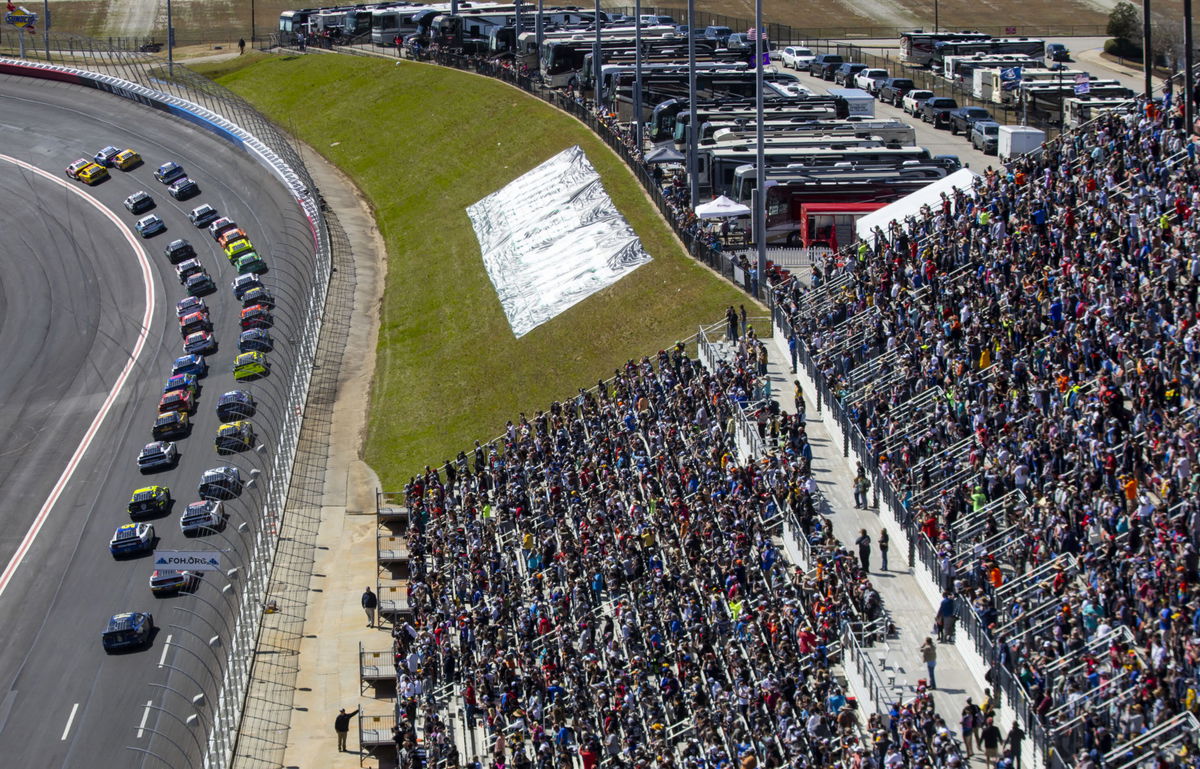
Imago
Mar 20, 2022; Hampton, Georgia, USA; Fans in the crowd look on as the field of NASCAR Cup Series drivers race into turn one to begin the Folds of Honor QuikTrip 500 at Atlanta Motor Speedway. Mandatory Credit: Mark J. Rebilas-USA TODAY Sports

Imago
Mar 20, 2022; Hampton, Georgia, USA; Fans in the crowd look on as the field of NASCAR Cup Series drivers race into turn one to begin the Folds of Honor QuikTrip 500 at Atlanta Motor Speedway. Mandatory Credit: Mark J. Rebilas-USA TODAY Sports
Apart from being one of the most exciting sports in the world, motorsport is arguably the most dangerous. The track matters a great deal when it comes to incidents like these. Some tracks have the reputation of being fairly safe for drivers to run at high speeds, but some tracks are notoriously dangerous. One such track used to be the Atlanta Motor Speedway, which has seen its fair share of fatal tragedies throughout its history. Even in a competition as big and well-organized as the NASCAR Cup Series, things have gone sideways at the superspeedway, forcing the organizers to bring forth drastic changes.
Watch What’s Trending Now!
Today, the Atlanta Motor Speedway looks nothing like it used to back in the 70s and 80s. It was during that time that the track saw the worst of its tragedies. The fact that it has been a long time since any untoward incident has taken place at the venue in the Cup Series is a nod to NASCAR and its proactiveness in ensuring a safe environment for the drivers. But one mustn’t forget the victims claimed by the circuit.
ADVERTISEMENT
Five years apart, 2 talented NASCAR racers lost their lives in Atlanta
From its opening in 1960 to 1984, the Atlanta Motor Speedway was considered being one of the best tracks in the Cup Series calendar. No driver fatalities had taken place at the venue and the racing was hard, fast, and entertaining. Fans at the time were enthralled by the action that unfolded before their eyes, and the superspeedway became a venue with a lot of demand, selling out completely each year. However, the first driver tragedy struck in ’84.
It was the fourth race of the 1984 Cup Series season. In the race before at Rockingham, Terry Schoonover made his debut in the competition, driving his own #42 car. His qualifying run in Atlanta did not go to plan at all as he could manage a starting position of only P36 and his objective was to just finish the race. However, on lap 129, Schoonover hit the outside wall and lost control of his car. The #42 came sliding down the track and onto the grass, coming to an abrupt halt at a dirt embankment.
It was tough getting the driver out of the car and officials were left with no choice but to cut the roof of the car to get it away from the embankment. Schoonover was then retrieved from the car and airlifted to a local hospital, but it was too late. The driver passed away due to head and internal injuries. He was 32.
ADVERTISEMENT
ADVERTISEMENT
Tragedy struck once again 5 years later, once again at the Atlanta Motor Speedway again as five years later, there was another tragedy. Grant Adcox was a man who had a lot of potential. His talent shone through in the ARCA Series and perhaps he would have been able to make an impact on the Cup Series. At the 1989 Atlanta Journal 500, Adcox met with a nasty crash on lap 202. His car seat, which was not fixed properly by his team, was flung out of place, resulting in the driver sustaining severe head and chest injuries.
It was a tall order for the safety crew to get Adcox out of his car given the way he had crashed, and it took them 12 whole minutes to get him out. Once they did, the driver was airlifted to the Georgia Baptist Hospital in Atlanta, but unfortunately, he succumbed to his injuries. An investigation was launched into the matter by NASCAR and it was concluded that the team had not installed Adcox’s seat properly. He was 39.
ADVERTISEMENT
ADVERTISEMENT
Driver deaths are not the only tragedies to have taken place in NASCAR in its long history. Crew members also put their lives at risk whenever they jump out onto the pit road amidst a sea of stock cars. Sometimes, things go sideways and the Atlanta Motor Speedway was witness to 2 such events.
Read More – Gentleman’s Rule in NASCAR- the Lost Way of Drivers Self Policing
Top Stories
Florida Police Arrest Millionaire NASCAR Veteran Over Disturbing Public Misbehavior

Denny Hamlin Demands Immediate Apology From FOX Broadcaster After Michael Jordan’s Lawsuit Triumph

Hailie Deegan & Others Speculated to Fill NASCAR Seat After Star Driver’s Ugly Exit

Departing NASCAR Star’s Father Pens Emotional Note After Parting Ways with Dale Jr.

Dale Jr. Details NASCAR’s Massive Blunder in Savage Takedown of Leadership Decisions

ADVERTISEMENT
Pit road lockups claimed the lives of 2 crew members
The Atlanta Motor Speedway holds the infamous record of having two of the most recent non-driver fatalities in the history of the NASCAR Cup Series. The first of them took place in 1979, almost 2 decades since the track’s opening. 1977 ASA champion Dave Watson was only making his fifth start in the Cup Series. After leading the race for a few laps, the then-33-year-old driver came into the pit for refueling purposes.
However, as he was reducing his speed, both of his rear wheels locked up and the car spun. At that time, an 18-year-old jackman, Dennis Wade, had already made his way from the other side of the wall with a heavy jack in hand. The spinning car caught him by surprise and there was nothing he could do to get out of the way. He was flung into the air as the car hit him. He was administered CPR and taken to the infield hospital before being transferred to the Clayton General Hospital. However, the teenager could not survive his injuries and Dave Watson quit racing in NASCAR altogether.
The second non-driver-related fatality took place only a year after Grant Adcox’s passing in 1989. The driver involved on this occasion was none other than former Cup Series champion Bill Elliott. It was the season finale of the 1990 Cup Series. Leading the race, Elliott came in for the final stop of the race. One of the mechanics in his crew was Mike Rich, who got to work on Elliott’s right-rear tire as soon as he stopped.
ADVERTISEMENT
While Rich was doing his job, he did not notice Ricky Rudd locking up his rear tires as he slowed down for his pitstop. What ensued was pure chaos, and the TV cameras at the time caught everything. Rudd’s car slammed into Elliott’s while it was being serviced, slamming Mike Rich in the process. People on the pit road frantically did everything possible to get Rich out from underneath Rudd’s car. He was taken to a local hospital in Atlanta but could only survive for a couple of hours before drawing his final breath due to a cardiac arrest.
ADVERTISEMENT
Since then, the Atlanta Motor Speedway has thankfully not seen any fatality in the NASCAR Cup Series, driver or non-driver-related. Safety has been romped up manifold from the 1980s, but everyone involved still has to be extremely careful. We can all be grateful the safety standards in NASCAR are of the highest level, but must never forget the lives taken by the sport.
Watch this Story: Kyle Busch brings in another sponsor for Richard Childress Racing
ADVERTISEMENT
ADVERTISEMENT
ADVERTISEMENT

